A Storied History
When the citizens of Normandy passed a bond allowing Normandy School District officials to purchase the Bellerive Country Club for $600,000 in 1957 for a community college site, the plan was locally criticized as a "speculative venture." Despite this criticism, a bond issue was passed to buy the 128 acre tract of land that included a club house, golf course, swimming pool, volleyball and tennis courts, and lake. Two years later, in September 1960, the two-year Normandy Residence Center opened for classes. Enrollment totaled 215 freshmen, who squeezed into 12 classrooms in the old clubhouse. Four full-time and eight part-time faculty were provided by the University of Missouri.
After three years of operation as a residence Center, the Normandy School District and the university reached an agreement for the university to purchase the property and assume operation of the center in order to bring a four-year public higher education option to St. Louis. At the time, state law mandated that public schools solicit competitive bids when selling excess property, but that process didn’t appeal to either the district or the university. That’s when lawmakers Wayne Goode, of Normandy, and Robert Young, of St. Ann, stepped in. In January 1963, state Rep. Goode introduced the 78-word House Bill 153, and state Sen. Young introduced a companion bill in the Missouri Senate to make the proposed land transfer legal. Both supported bringing the University of Missouri to St. Louis and were sold on the merits of creating that campus in the Normandy area, as was Missouri Gov. John Dalton. The legislation passed and in September 1963, the Normandy Residence Center officially became the University of Missouri–St. Louis.
The Bellerive Country Clubs clubhouse remained the only campus structure until 1966, when Benton Hall, the first classroom-laboratory building, was completed, followed by Clark Hall in late 1968, the Thomas Jefferson Library in 1969, and Stadler Hall in 1970. Classroom space was nearly doubled in 1971 with the completion of five more buildings: The Mark Twain Building; the University Center, the student union; the J.C. Penney Building, the first privately financed building on campus; Lucas Hall, the home of the College of Arts and Sciences; and the Social Sciences and Business Building. In 1976 construction was completed on two more buildings: the General Services Building and Woods Hall, the central administration building. In 1976 the university also purchased the former Marillac College south of Natural Bridge Road and thus acquired the cornerstone of what would become the South Campus.
The 1990s was a decade of rapid growth for the campus with the addition of the dormitory, chapel, and administration buildings of the Sacred Heart Sisters, which afforded on-campus living for the first time in UMSL history. The Passionist Fathers Retreat Center was also acquired, adding more dormitory rooms for residential students. The University Meadows, a gated student apartment complex was built in a public/private partnership, which utilized undeveloped land adjoining the South Campus. The Kathy J. Weinman Building was funded by private donations and now houses the Childrens Advocacy Center and the Center for Trauma Recovery. And, in 1999, the Provincial House buildings of the Daughters of Charity were added.
Also during this time, the campus began a series of property acquisitions surrounding the North Campus in the communities of Normandy and Cool Valley along either side of University Boulevard (formerly North Florissant Road), and in unincorporated St. Louis County bounded by I-70, Hanley Road, and Natural Bridge Road. The William L. Clay Molecular Electronics Building and the studio arts complex were added and, in 2002, the Normandy Hospital building as acquired, bringing the South Campus complex to 44 acres, more than 20 buildings, and 1,000 residential units. Today, the South Campus is home to the Pierre Laclede Honors College, the College of Education, the College of Nursing, and the College of Optometry.
The Millennium Student Center opened its doors in 2000. Funded by students, the center is a one-stop-shop for student services and boasts event space, campus dining, study spaces, and a sky bridge connecting to the to the core academic quadrangle of the North Campus. The 2000s also brought a redesign of West Campus Drive, connecting the entrance to Natural Bridge Road; the completion of three 600-space parking garages, one on West Campus and two on East Campus drive; the acquisition of the St. Louis Mercantile Library; construction of the Computer Center Building; and the opening of the $56 million Blanche M. Touhill Performing Arts Center.
In recent years the campus has benefited from the additional construction and renovation of additional academic and student life spaces, including a renovation of the science complex in Benton and Stadler Halls and the conversion of the General Services Building into a home for the former College of Fine Arts and Communication (now the School of Fine and Performing Arts). In 2012 the Student Government Association voted to fund the $36 million Recreation and Wellness Center, which opened in 2015 and featured state-of-the-art fitness equipment, a rock-climbing wall, a 155,000-gallon pool, and more. 2016 saw the addition of the 75,000-square-foot Science Learning Building on North Campus, a $35 million project bond-funded at the recommendation of the University Assembly Budget and Planning Committee to improve science learning facilities.
The state of Missouri invested in UMSL's infrastructure in 2015 with the announcement of $13.6 million in state bond funds to further renovate Benton Hall and the release of $10 million in 50/50 matching funds to construct a new business building. Anheuser-Busch Hall, named in honor of a lead $2.5 million gift from the Anheuser-Busch Foundation, opened in 2017 as the home of the College of Business Administration.
The foresight of the people involved in that "speculative venture" has been substantiated by time. Today, the University of Missouri-St. Louis has an enrollment of more than 17,000 students, making UMSL the second largest of the University of Missouri System's four campuses, the largest university in the St. Louis area, and the third largest in the state. On what was once the site of a country club with a single building, UMSL has grown to a campus of more than 50 buildings and structures situated on over 470 acres. Via Metrolink stops on both the South and North Campuses, students have direct access to the numerous educational, cultural, social, shopping, entertainment and sports complexes in St. Louis County and in Downtown St. Louis. Far from its humble beginnings, UMSL offers a full campus life experience to students from St. Louis and around world, including students from some 100 countries.
Former Chancellors
| Thomas F. George 2003-2019 |
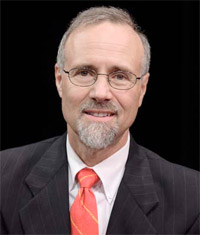 |
Donald Driemeier (Interim) 2003-2003 |
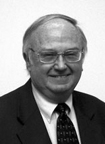 |
| Blanche Touhill 1990-2002 |
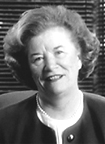 |
Marguerite Ross Barnett 1986-1990 |
 |
| Arthur MacKinney (Interim) 1985-1986 |
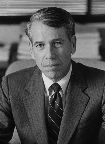 |
Arnold Grobman 1975-1985 |
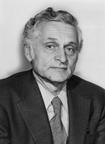 |
| Emery Turner (Interim) 1974-1975 |
 |
Joseph Hartley 1973-1974 |
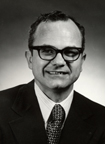 |
| Everett Walters (Interim) 1972-1973 |
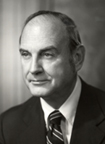 |
Glen Driscoll 1969-1972 |
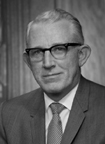 |
| James Bugg 1965-1969 |
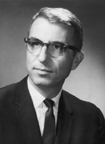 |
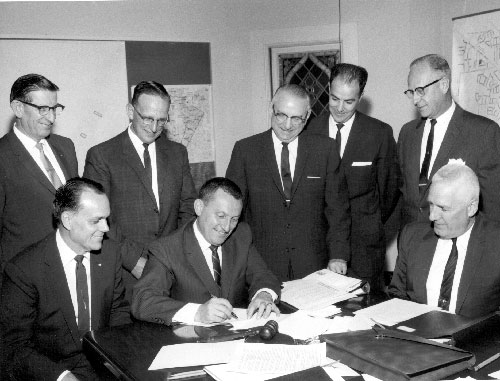
Edward Monaco, President of Normandy Board of Education, signs papers establishing the University of Missouri Normandy Residence Center. Behind him on his left is Ward E. Barnes, Superintendent of the Normandy School District, c. 1960
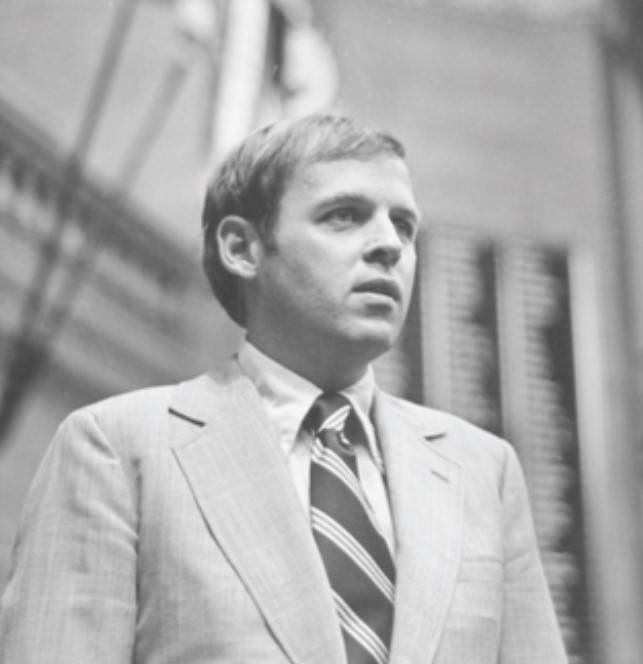
Rep. Wayne Goode introduced legislation in January 1963 to facilitate the creation of the University of Missouri–St. Louis and, in turn, unlocked educational opportunity for legions of students to chase their dreams and advance their futures.
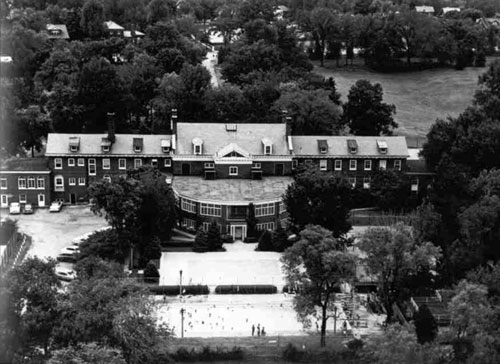
Bellerive Country Club, c. late 1950s, was the only building on campus until Benton Hall was built in 1966. It was known as the Administration Building and housed classrooms, offices, and the library.
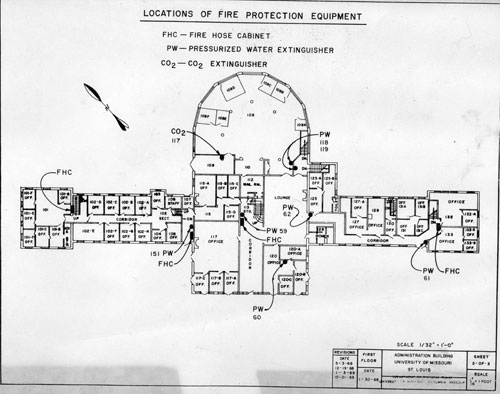
Fire safety plan of the Administration Building, 1968
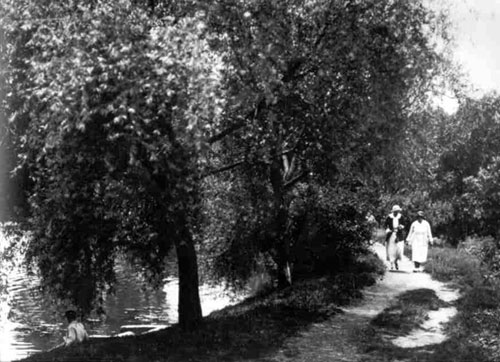
Members of Bellerive Country Club often swam in what later became known as Bugg Lake--named after the University's first Chancellor, James Bugg
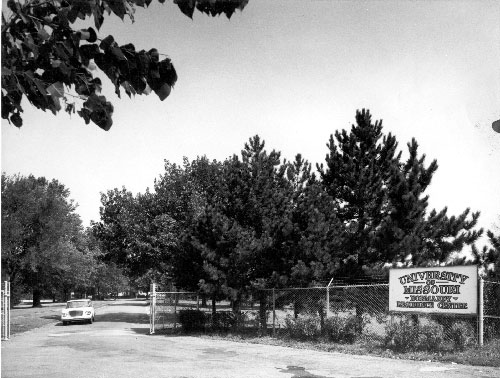
Entrance off Natural Bridge Road into the University of Missouri Normandy Residence Center as the campus was called between 1960-1963.
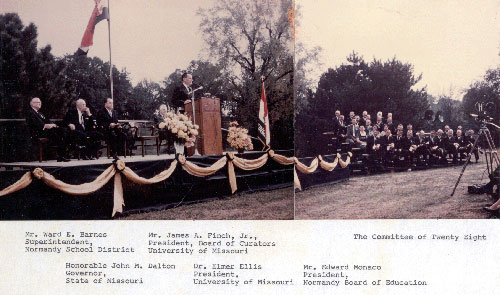
As enrollments grew, University of Missouri officials expressed an interest in turning the Normandy Residence Center into a four year UM campus. In the Fall of 1963 with over 600 students enrolled, Normandy School District proudly committed its campus to the University of Missouri-St. Louis.
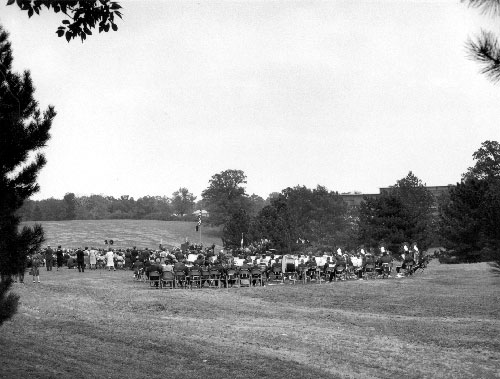
Over 100 people turned out for the dedication ceremonies as the Normandy Residence Center became the University of Missouri-St. Louis on September 15, 1963. The ceremony was held on the site now occupied by Woods Hall.
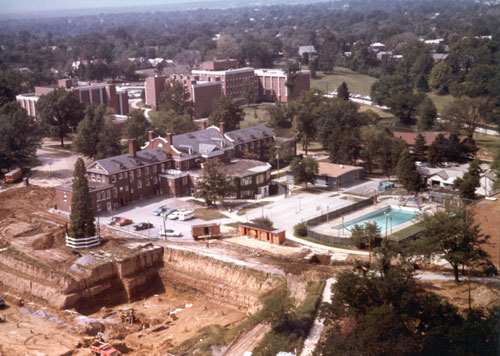
Aerial view of campus looking southwest. Excavation for construction of the J.C. Penney building in foreground. Benton and Stadler Halls shown in background. Administration Building, the former Bellerive Country Club club house shown in middle.
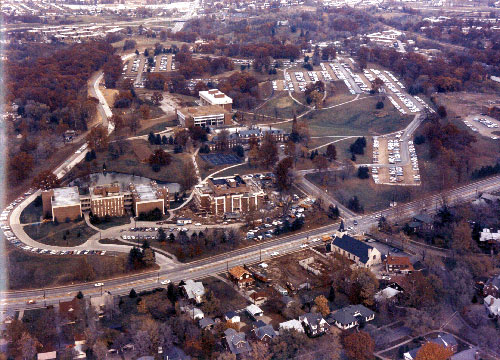
Aerial view of campus looking northeast showing Benton and Stadler Halls, Administration Building Thomas Jefferson Library and Clark Hall, c. 1969.
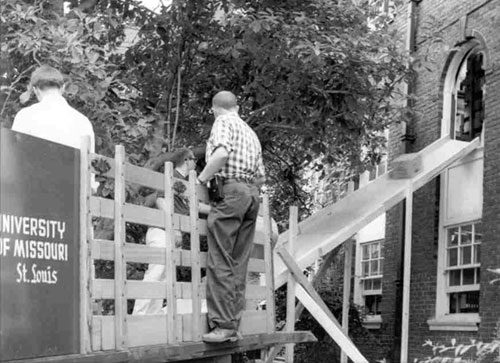
Workers transporting books out of the Administration Building library to be placed in the newly constructed Thomas Jefferson Library, 1969.
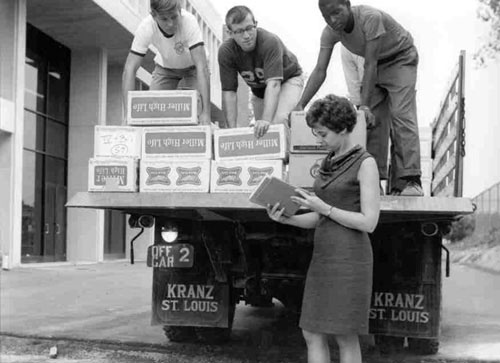
Susan Freegard, UM St. Louis' first library director, oversees the move into the newly built Thomas Jefferson Library, 1969.
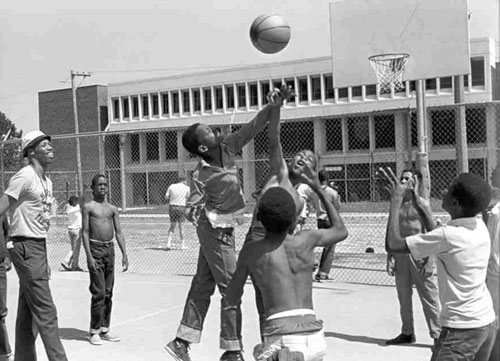
In 1969, UMSL received a grant from the U.S. Department of Health Education and Welfare to provide recreational activities for inner city youth. Athletic facilities on campus provided over 200 St. Louis area youth a chance to hone their skills. Thomas Jefferson Library in background.
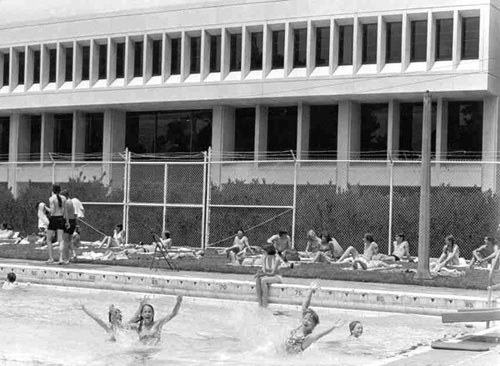
Swimming and sunbathing in front of the Thomas Jefferson Library, c. 1970s, The pool was opened to full-time days students in May of 1965. The pool was built in 1932 as part of the Bellerive Country Club.
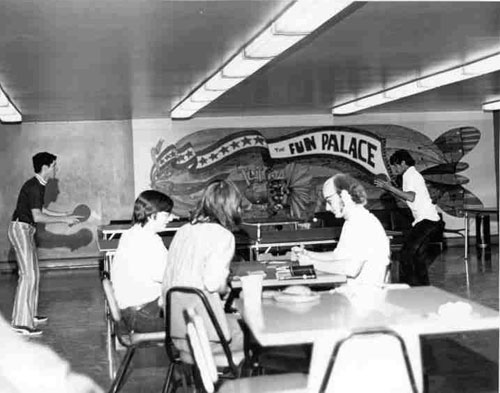
The Fun Palace, near Bugg Lake, provided students a place to play ping pong or pool or enjoy a snack. The building originally contained the Physics department labs and was known as the Physics Annex.
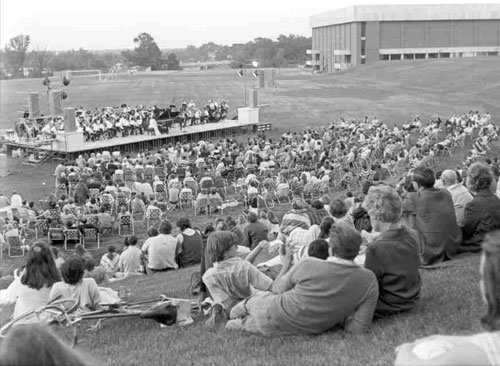
Leonard Slatkin directs the St. Louis Symphony orchestra in a free concert on the athletic fields, 1977. Airplane traffic was temporarily redirected to ensure good acoustics.
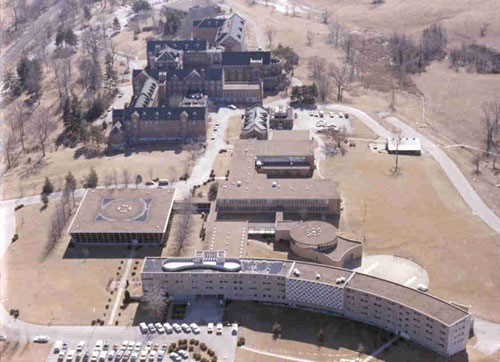
Marillac Campus, also known as the South Campus, was previously the site of Marillac College, a four year liberal arts school run by the Daughters of Charity of St. Vincent DePaul. Marillac College opened in 1958 to educate Catholic sisters and offered degrees in teacher education, nursing and social work. The Daughters of Charity began subdividing their property as enrollments dropped in the early 1970s. The University of Missouri-St. Louis purchased the Marillac Campus in 1976 for $5 million. The School of Education and the Education Library became its first occupants. In 1998, UMSL acquired the Marillac Provincial House and six other buildings from the Daughters of Charity.
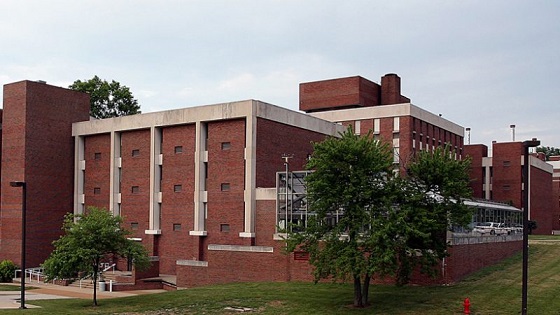
Benton Hall was the first building constructed on the university’s then-new campus in 1964. It’s part of a North Campus complex that includes the William L. Clay Center for Nanoscience, Anheuser-Busch Ecology and Conservation Complex, Research Building, Stadler Hall and the forthcoming Science Learning Building.
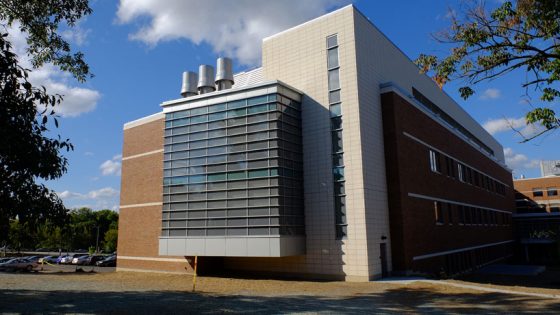
The Science Learning Building is four stories and 75,000 square feet, with 18 labs, seven new study areas, a solarium and a new Sodexo Simply to Go Café.
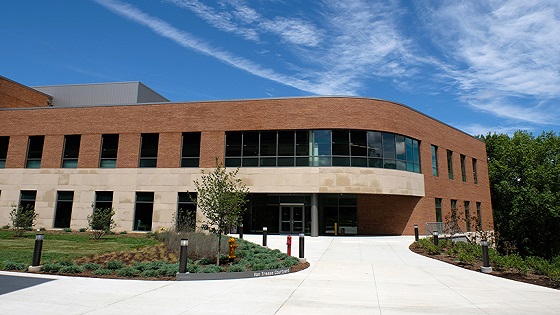
Anheuser-Busch Hall, the first space on UMSL’s campus solely dedicated to business education, opened for classes in August 2017.
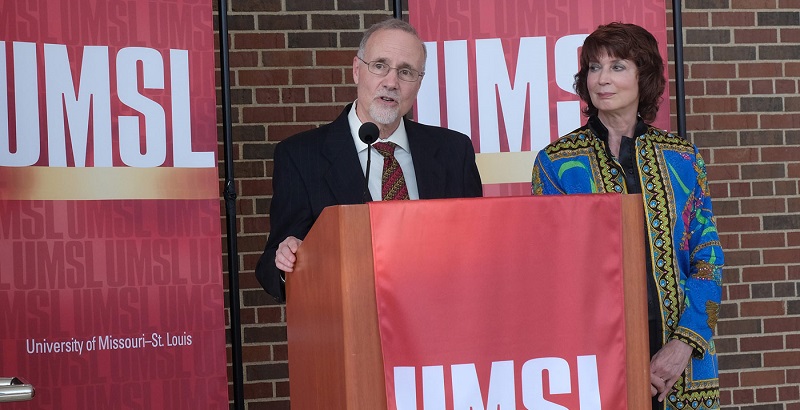
During his 16 years at UMSL, Chancellor Thomas F. George oversaw a physical transformation of the campus while also helping the university deepen its roots as an anchor institution in the St. Louis region. George and his wife, Curators Distinguished Professor of Music, both retired on September 1, 2019.